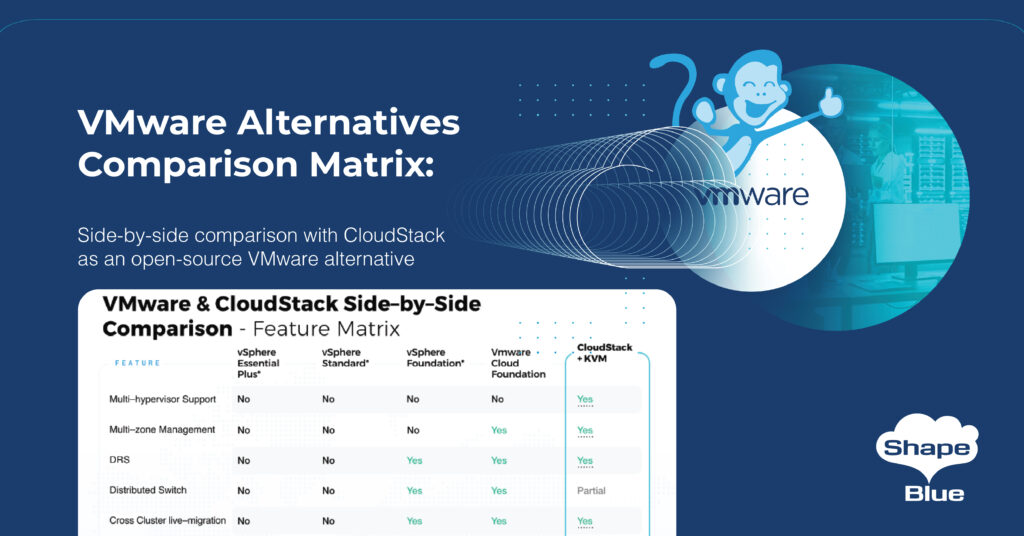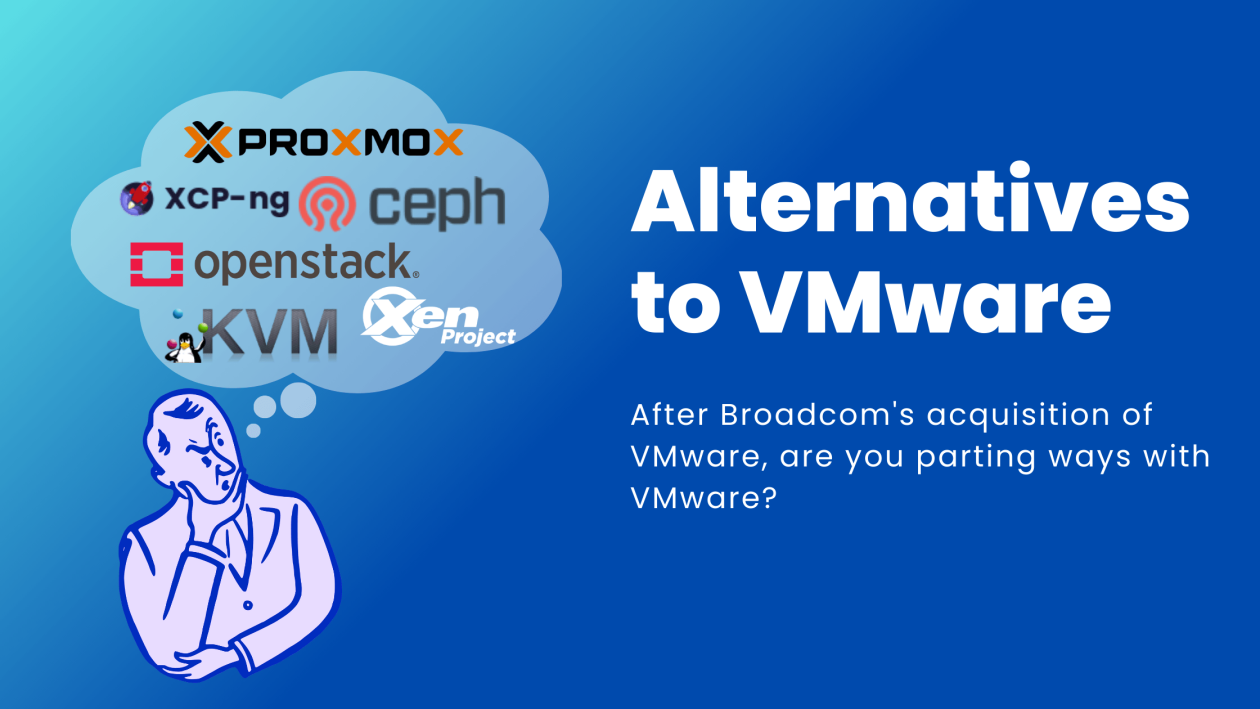Beyond VMware: Top Alternatives To Consider In 2025
Are you feeling the pinch of rising costs and uncertain futures in your virtualization strategy? The landscape of virtualization is shifting, and savvy IT professionals are actively seeking alternatives to VMware, making it a crucial time to explore your options.
The virtualization arena, once dominated by a single giant, is now teeming with competitors. VMware, a name synonymous with virtualization, finds itself at a crossroads. Broadcom's acquisition of VMware has sparked a wave of introspection, pushing organizations to re-evaluate their cloud strategies, modernization efforts, and, crucially, their budgets. This isn't just a minor shift; it's a paradigm change. The days of unquestioned loyalty are fading, replaced by a pragmatic assessment of value, performance, and future-proofing.
It's crucial to understand that choosing a VMware alternative is not a one-size-fits-all decision. Your organization's size, specific needs, goals, and budget are the guiding stars in this complex process. While VMware still holds a significant market share, the advantages of exploring alternatives are becoming increasingly clear. Many IT professionals are exploring options due to factors such as the potential for significant cost savings, the desire for greater flexibility and scalability, and the need for solutions better aligned with their evolving cloud strategies. While VMware often requires hefty licensing fees, many alternatives offer free or competitively priced solutions.
Let's delve into the key considerations, the top contenders, and the crucial factors that will determine your virtualization future. Before you commit, you need to analyze all available options. Let's start exploring the options.
The Drivers of Change: Why Consider Alternatives?
The reasons for this surge in alternative exploration are multi-faceted. The most prominent catalyst is undoubtedly the impact of Broadcom's acquisition. This takeover has introduced uncertainty and, in many cases, increased costs for VMware customers. Price hikes, licensing model changes, and shifts in product focus are prompting businesses to reconsider their long-term investments in the platform. This is leading many organizations to actively seek alternatives for their private cloud solutions.
- Tami Tsunami From Onlyfans Star To Music Controversies Explained
- Movies4u Where To Watch Download Free Movies Guide
Beyond the acquisition, other forces are at play. The need for agility and flexibility in a rapidly changing IT landscape is paramount. Businesses are demanding solutions that can quickly adapt to evolving workloads, scale on demand, and integrate seamlessly with cloud environments. Legacy virtualization platforms, including VMware, can sometimes struggle to keep pace with these demands. In addition, the quest for greater control and customization is a driving factor. Some organizations prefer solutions that allow them to tailor their virtualization infrastructure to their specific needs, rather than being locked into a rigid, vendor-defined framework.
Navigating the Alternatives Landscape: Key Considerations
Before you jump into a migration, a thorough assessment of your needs is critical. Here are the fundamental aspects to consider:
- Workload Requirements: What types of applications are you virtualizing? Are they primarily Windows-based, Linux-based, or a mix? Some platforms excel in specific workload environments.
- Scalability and Performance: How much capacity do you need now, and what are your future growth projections? Ensure the alternative can handle your expected workload demands without performance bottlenecks.
- Budget: Licensing costs are a primary driver for change. However, factor in implementation, training, and ongoing maintenance costs when comparing solutions.
- Integration: Does the alternative seamlessly integrate with your existing infrastructure, including storage, networking, and cloud services?
- Management and Automation: What tools are available for managing and automating your virtualized environment? Consider ease of use, monitoring capabilities, and automation features.
- Security: What security features are available to protect your virtualized environment from threats? Evaluate security features for compliance.
- Support and Community: Does the platform offer robust support, documentation, and a thriving community for assistance and knowledge sharing?
The Top Contenders: Exploring the Leading VMware Alternatives
The market is brimming with viable alternatives to VMware, each with its strengths and weaknesses. Here are some of the leading contenders, offering a diverse range of features, pricing options, and strategic advantages:
1. Red Hat OpenShift:
Red Hat OpenShift is a leading Kubernetes platform designed for modern application development and deployment. While not a direct replacement for VMware vSphere in the traditional sense, OpenShift provides a powerful environment for containerization and cloud-native applications. It offers a comprehensive set of tools for managing containerized workloads, automating deployments, and scaling applications. OpenShift's strengths lie in its ability to streamline the development lifecycle and support cloud-native architectures.
2. Azure Virtual Machines:
For organizations heavily invested in the Microsoft ecosystem, Azure Virtual Machines (VMs) offers a compelling alternative. Azure VMs provide a robust and scalable infrastructure-as-a-service (IaaS) solution, allowing you to run virtual machines in the cloud. Azure VMs offer a wide range of operating system support, a variety of instance sizes, and seamless integration with other Azure services. Azure's strengths include its scalability, its pay-as-you-go pricing model, and its comprehensive suite of cloud services.
3. Microsoft Hyper-V:
Bundled with Windows Server at no additional cost, Hyper-V provides native integration and support for Windows workloads. It's a good option for organizations running primarily Windows-based environments and seeking to reduce costs. Hyper-V is a type 1 hypervisor, offering performance and efficiency. The advantage of Hyper-V lies in its cost-effectiveness, ease of integration with Windows Server, and its solid performance in Windows-centric environments.
4. Citrix XenServer:
Citrix XenServer is a powerful and flexible virtualization platform, offering a comprehensive set of features for managing virtual machines. XenServer is known for its high performance and its ability to handle demanding workloads. It supports various operating systems and offers advanced features such as live migration and high availability. Citrix XenServer's strengths are its performance, features, and its suitability for demanding environments.
5. Nutanix AHV:
Nutanix AHV is the built-in hypervisor for the Nutanix Enterprise Cloud Platform. AHV offers a streamlined approach to virtualization, with a focus on simplicity and ease of management. It integrates seamlessly with Nutanix's hyperconverged infrastructure (HCI) solutions, providing a unified platform for compute, storage, and virtualization. Nutanix AHV's strengths lie in its ease of use, its integration with HCI, and its focus on simplicity.
6. Proxmox VE:
Proxmox VE is an open-source virtualization platform based on Debian Linux. It supports both KVM (Kernel-based Virtual Machine) for virtual machines and LXC (Linux Containers) for containerization. Proxmox VE is a cost-effective and versatile solution, offering a wide range of features and a strong community support. Its strengths include its open-source nature, its flexibility, and its ease of use.
7. Oracle VM VirtualBox:
Oracle VM VirtualBox is a free and open-source virtualization solution. It's popular for personal use and smaller businesses. VirtualBox supports a wide range of operating systems and allows you to run multiple virtual machines on a single physical machine. VirtualBox is an excellent choice for testing and development environments, due to its open-source nature, ease of use, and cross-platform compatibility. It is also a solid choice for personal and enterprise use.
8. KVM (Kernel-based Virtual Machine):
KVM is a virtualization infrastructure for the Linux kernel. It allows you to turn a Linux system into a hypervisor. KVM is open-source and is often used as the foundation for other virtualization solutions like Proxmox VE. KVM offers high performance and flexibility and is a favorite among system administrators and developers who value control. Its strength is its integration with the Linux kernel, the performance, and the customization options.
9. QEMU (Quick EMUlator):
QEMU is a generic and open source machine emulator and virtualizer. QEMU can run operating systems and programs made for one machine (like an ARM device) on a different machine (like your x86 PC). When used as a virtualizer, QEMU offers near-native performance. This makes it a flexible tool for a wide range of virtualization tasks and is often combined with KVM. QEMU is especially useful for running operating systems on the hardware that is very different from your own system.
Making the Right Choice: Tailoring Your Selection
As we mentioned, there is no single "best" alternative. The optimal choice hinges on your specific requirements. For organizations primarily focused on cloud-native applications and containerization, Red Hat OpenShift provides an excellent platform. For those deeply integrated with the Microsoft ecosystem, Azure Virtual Machines offer a robust and scalable solution. Companies primarily using Windows server may consider Hyper-V.
Explore diverse features, pricing options, and unique advantages that cater to various business needs and virtualization strategies. Always choose the one that offers excellent scalability and flexibility to meet and tweak the needs on the go. If your goal is more azure integrated services and management, azure local is probably the best alternative. If VMware's future feels shaky, you're not stuck without options. Discover the eight best VMware alternatives to consider in 2025. Whether they are really suitable as an alternative depends heavily on individual requirements.
Important note: To level set, we arent referring to desktop virtualization solutions like VMware Workstation with alternatives like VirtualBox, rather enterprise solutions. These are enterprise solutions, the solutions listed here offer similar functions to VMware virtualization products.
The Future of Virtualization: Beyond the Horizon
The virtualization landscape is in a state of dynamic evolution. The shift towards cloud-native architectures, containerization, and hybrid cloud strategies is reshaping how we approach virtualization. It's crucial to stay informed about the latest trends and technologies. This is an era of choice, demanding proactive research, thorough assessment, and a clear understanding of your unique needs. The solutions listed here offer similar functions to VMware virtualization products. The best VMware vsphere alternatives are Red Hat OpenShift, Azure Virtual Machines, and VirtualBox. Read the latest reviews, pricing details, and features. Learn more about the top vSphere competitors and alternatives. Read the latest reviews and find the best server virtualization software. Always choose the one that offers excellent scalability and flexibility to meet and tweak the needs on the go.
- Aileen Wuornos Tyria Moore The Story You Didnt Know
- Diva Flawless Latest News Tiktok More 2024 Updates

VMware Alternatives Comparison CloudStack open source VMware alternative

Alternatives to VMware Kubedo Cloud

7 Alternatives to VMware vSphere